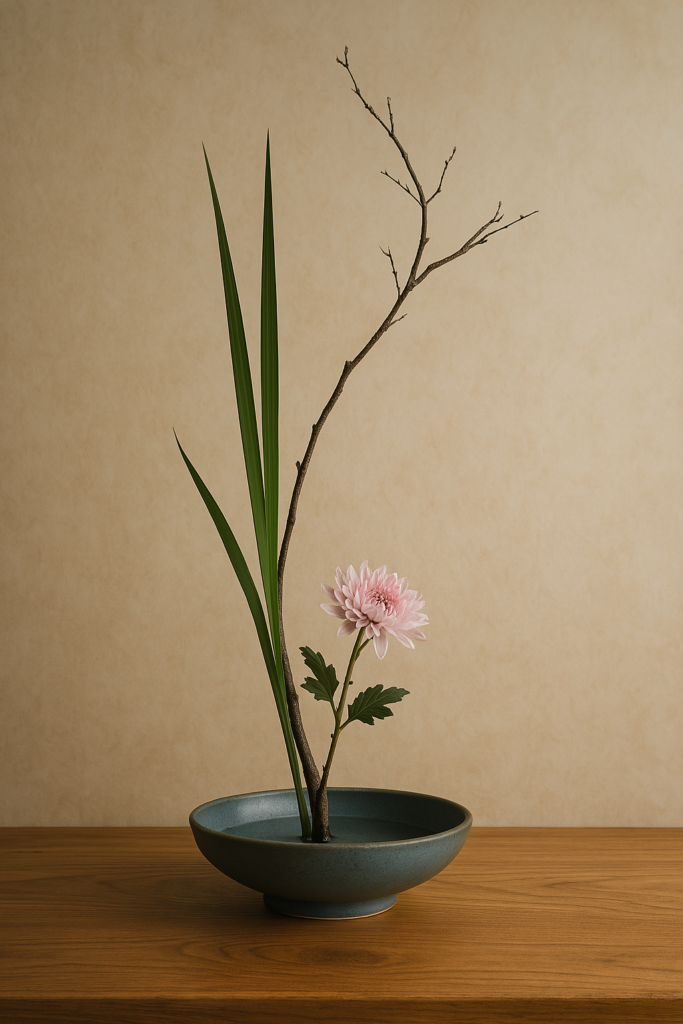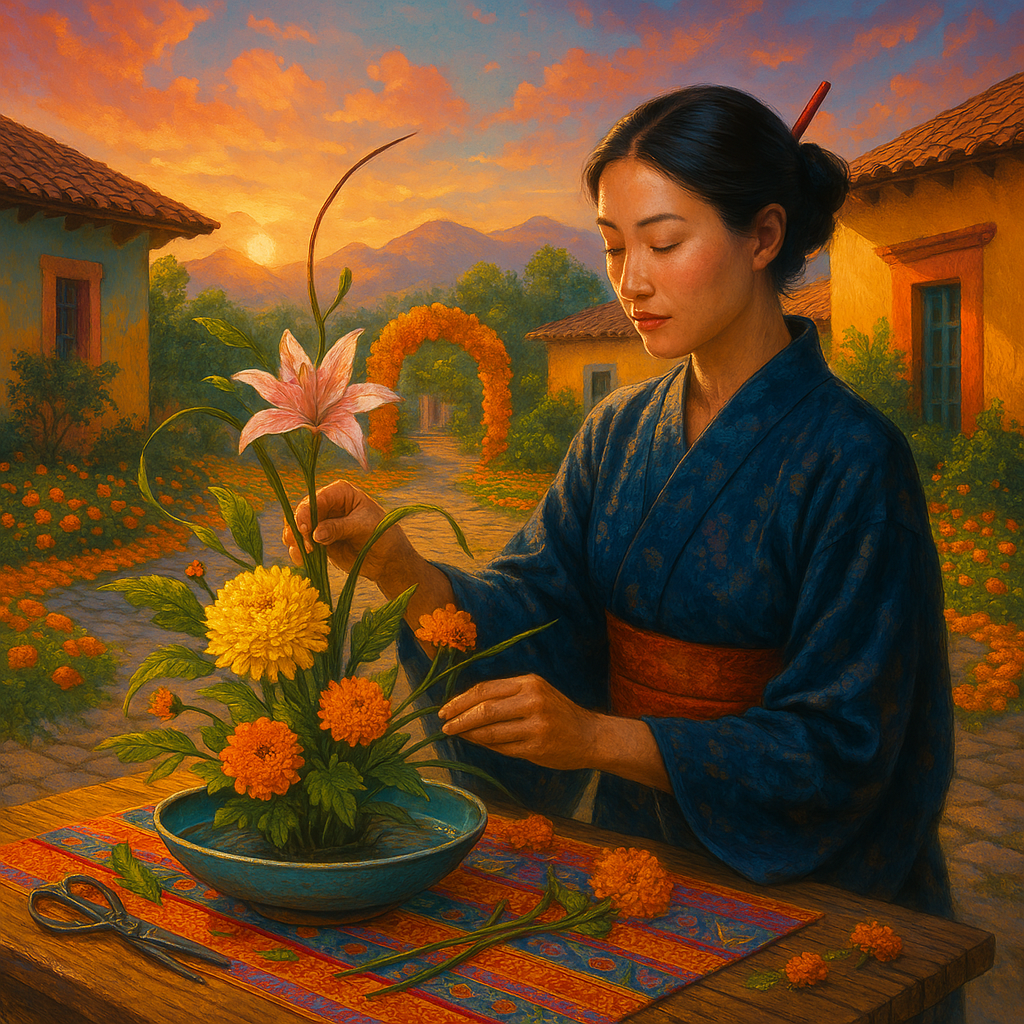🌿 What is Ikebana?
Ikebana (生け花) means “making flowers come alive” or “giving life to flowers.” It is the Japanese art of floral arrangement — but not in the way you might imagine. Unlike Western-style arrangements that emphasize volume and color, Ikebana flower arrangements are minimalist, often using just a few branches, flowers, or leaves in deliberate harmony with space and form.
In Ikebana, everything matters: the line of a stem, the angle of a leaf, the choice of ikebana vase, the empty space between elements. The final arrangement is a meditation on nature, impermanence, and inner reflection.
This sacred art has evolved into many schools and styles, from classical to contemporary, but the core purpose remains the same: to create harmony between the natural world and human expression.
Far more than decorating with blossoms, Ikebana is a conscious, meditative act of placing nature in balance, drawing from centuries-old wisdom and spiritual philosophies. It is healing, artistic, and spiritual — a calming ritual that continues to inspire seekers of inner peace and wellness across the world.
Let’s explore the essence of Ikebana flower arrangements, the spiritual path behind them, their connection to Zen Buddhism and Taoism, and how you can use this practice as a gateway to mindfulness and healing. 🌿
🏯 The History of Ikebana: A Sacred Offering
The origins of Ikebana date back more than a thousand years to when Buddhism first arrived in Japan. In the early days, monks would place flowers as offerings on temple altars to honor the Buddha. These simple floral tributes symbolized transience, devotion, and spiritual clarity.
By the 15th century, this practice had evolved into an art form. The first known school, Ikenobō, was founded at Kyoto’s Rokkaku-dō Temple. Monks there began developing guidelines for Japanese flower arrangements based on cosmological, philosophical, and spiritual symbolism.
During the Muromachi period, Ikebana flourished among the samurai and aristocracy, who practiced it alongside tea ceremony, calligraphy, and Zen meditation. It became a way to cultivate self-discipline, grace, and awareness — reflecting a person’s character through their arrangement.
Today, Ikebana is practiced around the world, blending traditional techniques with modern creativity while remaining a pillar of Japanese aesthetics and wellness culture.
🧘 Ikebana and Zen Buddhism: Stillness in Bloom
Ikebana is more than a creative pursuit — it is deeply connected to the teachings of Zen Buddhism, where simplicity, presence, and awareness are central.
Like Zen meditation, Ikebana requires:
- Slowing down and observing with the heart
- Releasing control and embracing imperfection
- Becoming fully present with nature and the moment
Practicing Ikebana flower arranging allows one to enter a meditative flow. Every movement becomes intentional — cutting a stem, placing a leaf, observing the balance between the living and the void.
This aligns with Zen principles of:
- Mushin (no-mind): A state of being fully immersed without overthinking.
- Wabi-sabi: Beauty in imperfection and impermanence.
- Shizen: Naturalness and authenticity.
In this way, each Ikebana arrangement becomes a mirror of the self — a wordless diary of your inner state.
☯️ Taoist Influence: Harmony with Nature
Ikebana’s spiritual roots are also entwined with Taoism, the ancient Chinese philosophy that emphasizes balance, flow, and natural order.
Taoist principles in Ikebana include:
- 🌱 Flow of energy (Qi): The lines in an arrangement echo the invisible currents of life force.
- 🌀 Yin and Yang: The balance of upright and downward elements, color and space, soft and sharp.
- 🍂 Effortless action (Wu Wei): Arranging in harmony with nature’s inherent design, not forcing it.
This makes Ikebana not just a visual art, but a healing energy practice — one that aligns your spirit with the rhythm of life. Many consider it a form of energy healing without touch, similar to how Reiki or Qigong use flow and intention.

🧘♀️ Ikebana as a Meditative Practice
The modern wellness world is rediscovering Ikebana for what it truly is: a form of moving meditation that nurtures both mental clarity and emotional release.
How Ikebana Encourages Mindfulness:
- 🌺 It draws your attention to the present — every curve and color becomes important.
- 🌿 It reduces stress and anxiety by slowing thought loops and grounding the senses.
- 🌸 It encourages silence, breathing, and embodied awareness.
You don’t need to be an artist or spiritual expert to benefit. Simply sitting with your materials and arranging them with love is enough to feel its calming effect.
💚 Healing Through Japanese Flower Arrangement
Ikebana has long been seen as a healing art, both emotionally and spiritually. Like walking through a Zen garden or sipping ceremonial tea, it gently restores balance where there is disharmony.
Benefits of Practicing Ikebana:
- Stress relief – The meditative nature of arranging Japanese flowers is shown to reduce cortisol levels.
- Emotional clarity – The act of creating helps you express feelings that words often cannot.
- Creative flow – It taps into your intuition, promoting self-awareness and healing.
- Connection with nature – Working with seasonal materials fosters a deep sense of belonging and peace.
- Personal growth – Regular practice builds discipline, patience, and confidence.
Many wellness retreats and spiritual healing centers now include Ikebana workshops as part of their offerings, recognizing its power to calm the nervous system and uplift the soul.
🏡 Bringing Ikebana into Your Life
You don’t need to be in Japan or attend a temple to practice Ikebana. With just a few ikebana vases, some seasonal branches or flowers, and a quiet space, you can begin this journey of mindful floral design at home.
Starting Your Practice:
- Choose simple, natural materials — twigs, buds, leaves, and blooms that speak to you.
- Use an Ikebana vase — typically low and wide, allowing space and line to shine.
- Work in silence — create without music or distraction to fully immerse.
- Follow your intuition — allow the shapes to guide you rather than rigid rules.
- Reflect and observe — once completed, sit with your creation. What does it reveal?
Even just 10 minutes of Ikebana a week can enhance your mood, inspire clarity, and become a sacred ritual of self-connection.
🎎 Ikebana at Mind, Body & Spirit Events
We’re delighted to see Ikebana workshops becoming a popular feature at many holistic events, retreats, and wellness expos.
When you attend a Japanese floral arrangement workshop, you can:
🌸 Learn ancient Ikebana principles from trained instructors
🌸 Experience mindfulness through hands-on practice
🌸 Connect with others on a similar spiritual path
🌸 Explore different types of Ikebana vases and tools
🌸 Take home your creation as a meditative keepsake
These workshops are open to all — whether you’re a beginner or a lifelong creative — and provide a beautiful introduction to the healing magic of Ikebana design.

🪷 Final Thoughts: A Blooming Path to Inner Peace
Ikebana is not just an art form — it’s a spiritual path. It brings us into harmony with nature, into presence with ourselves, and into connection with something greater than words can express.
As a tool for meditation, emotional healing, and creative awakening, Ikebana offers a quiet yet profound way to heal and grow. 🌼
So whether you’re feeling overwhelmed, uninspired, or simply longing for more beauty in your day — let Ikebana guide you. One branch at a time. One breath at a time.
And remember: you, too, are a living arrangement of nature’s beauty.



